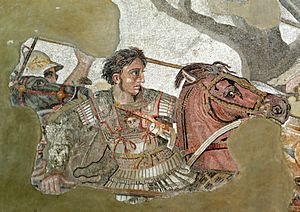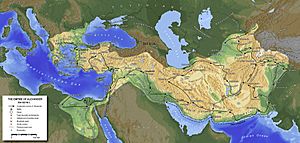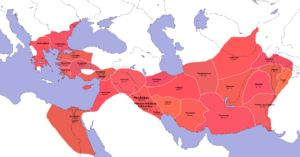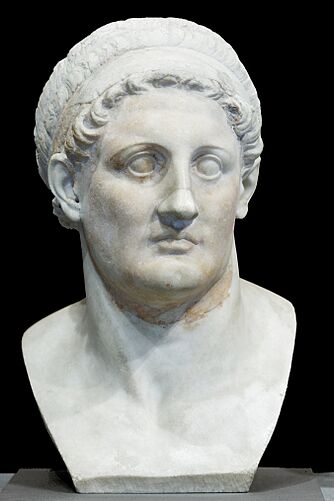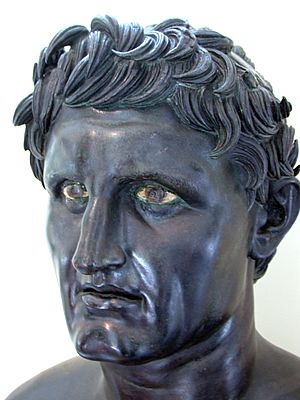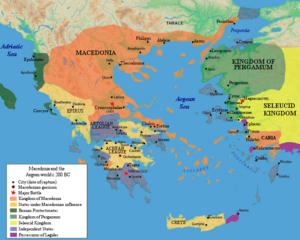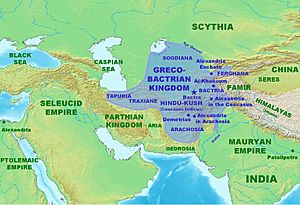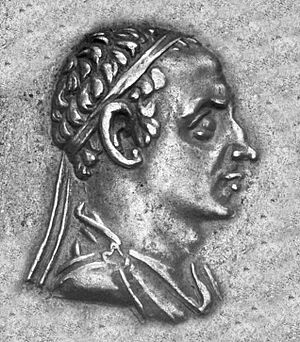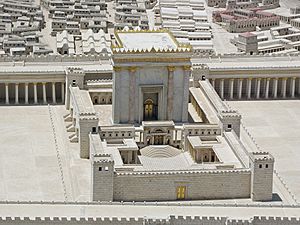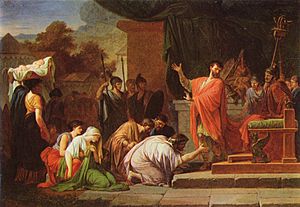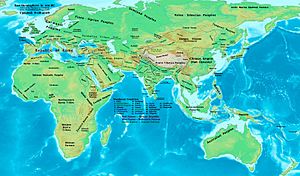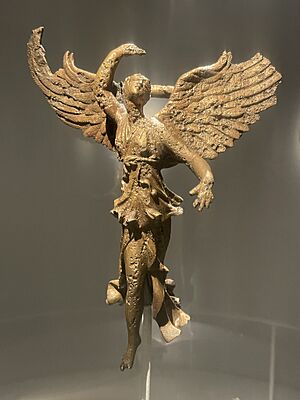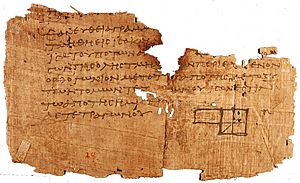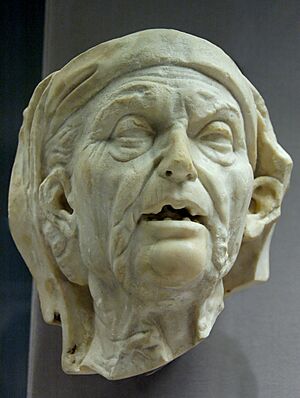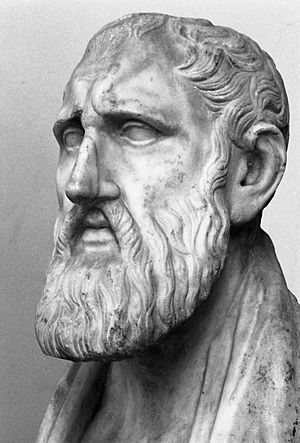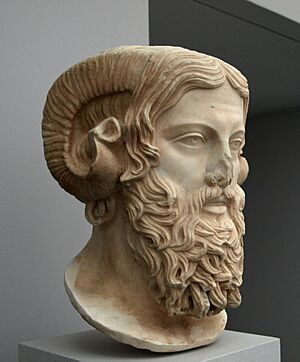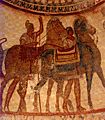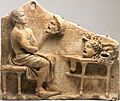Hellenistic period facts for kids
| 323 – 30 BC | |
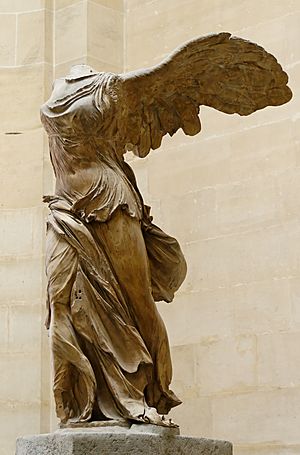
The Winged Victory of Samothrace (The Winged Nike) is a famous example of Hellenistic art.
|
|
| Preceded by | Classical Greece |
|---|---|
| Followed by | Greece in the Roman era |
The Hellenistic period was an exciting time in Greek and Mediterranean history. It began after the death of Alexander the Great in 323 BC and ended with the death of Cleopatra VII in 30 BC. This era saw the rise of the powerful Roman Empire. The name "Hellenistic" comes from the ancient Greek word Hellas, which means Greece. It describes a time when Greek culture spread far beyond Greece itself. This included many ancient lands that came under strong Greek influence, especially after Alexander the Great's amazing conquests.
After Alexander's empire broke apart, new Greek kingdoms appeared across West Asia, Northeast Africa, and South Asia. Many Greek people moved to these new lands, bringing their Greek culture and language with them. This spread of Greek influence reached as far as modern-day India! These new kingdoms also learned from the local cultures, creating a mix of Greek and other traditions. This blend led to a common Greek language called Koine Greek, which became widely spoken across the ancient world.
During this period, Greek culture became very important in the Mediterranean and beyond. It was a time of great progress in art, writing, theater, buildings, music, math, philosophy, and science. New forms of comedy and poetry appeared. Important thinkers like Euclid (a mathematician) and Archimedes (a brilliant inventor) made huge discoveries. Sculptures from this time showed strong feelings and movement, like the famous Winged Victory of Samothrace. People also built grand monuments with beautiful decorations, such as the Pergamon Altar. Even religion changed, with new gods like the Greek-Egyptian Serapis becoming popular. Greek culture even mixed with Buddhism in some eastern regions.
Historians have different ideas about when the Hellenistic era truly ended. Many agree it was around 31 or 30 BC, when the Roman Empire became the dominant power.
Contents
Alexander's Legacy and the Rise of New Kingdoms
The World After Alexander the Great
Before Alexander, Ancient Greece was a collection of independent city-states. After many wars, the kingdom of Macedon in northern Greece grew powerful under King Philip II. Philip united most of Greece under his leadership.
His son, Alexander the Great, took over after Philip's death in 336 BC. Alexander led his armies on incredible campaigns, conquering the vast Achaemenid Empire (Persia). His empire stretched across Asia Minor, Egypt, Mesopotamia, and parts of modern Afghanistan and Pakistan. Alexander died suddenly in 323 BC, leaving no clear successor.
After Alexander's death, his generals, known as the Diadochi (meaning "Successors"), began to fight over control of his huge empire. This led to many wars and eventually, the empire was divided into several large kingdoms. These new kingdoms were ruled by Alexander's generals and their families.
The Successor Kingdoms
The main kingdoms that emerged from Alexander's empire were:
- The Ptolemaic Kingdom in Egypt, ruled by Ptolemy and his descendants.
- The Seleucid Empire in West Asia, founded by Seleucus. This was the largest of the kingdoms.
- The Kingdom of Macedon in Greece, ruled by Antigonus and his family.
These kingdoms were often at war with each other, trying to gain more power and land.
Life in the Hellenistic World
Major Kingdoms and Regions
Ptolemaic Egypt: A Land of Pharaohs and Greeks
Ptolemy, one of Alexander's generals, became the ruler of Egypt. He declared himself king in 305 BC. His family, the Ptolemies, ruled Egypt for nearly 300 years. They built new cities like Alexandria, which became a major center for Greek culture and trade. Alexandria was famous for its huge library and lighthouse.
The Ptolemies adopted some Egyptian traditions, like marrying their siblings and being shown on monuments in Egyptian style. They also created a new god, Serapis, who combined Greek and Egyptian features. The Ptolemaic kingdom was very organized, with many officials collecting taxes to support the army and royal family. The most famous Ptolemaic ruler was Cleopatra VII, the last queen of Egypt.
The Vast Seleucid Empire
Seleucus, another of Alexander's generals, received Babylonia and built a huge empire. At its peak, the Seleucid Empire stretched from central Anatolia to parts of Pakistan. It had a very diverse population.
Like the Ptolemies, the Seleucids were ruled by a Greek-Macedonian elite. They founded many new cities, such as Antioch, which became centers of Greek learning. These cities had Greek-style buildings and institutions. The Seleucids often fought wars to keep control of their vast lands.
Attalid Pergamum: A Center of Learning
The city of Pergamum in Asia Minor became an independent kingdom after the death of Lysimachus, another of Alexander's generals. Its rulers, the Attalids, were strong allies of Rome.
Eumenes II made Pergamum a famous center of culture and science. He built the Library of Pergamum, which was almost as big as the Library of Alexandria. The city was also known for making parchment for books. The Attalids ruled until 133 BC, when their last king gave the kingdom to the Roman Republic.
Greece and its Leagues
During the Hellenistic period, the importance of mainland Greece decreased. The big cultural centers were now Alexandria and Antioch. Many young Greeks moved east to the new Hellenistic empires.
Greek city-states often had to ally with one of the larger kingdoms for protection. Athens, for example, sometimes allied with Ptolemaic Egypt against Macedon. Other city-states formed federated states like the Achaean League to defend themselves. These leagues had a central government for defense but let cities manage their local affairs.
Rhodes was one of the few city-states that stayed fully independent. With a strong navy, it protected its trade and became a rich center of culture and business. After a long siege, the Rhodians built the famous Colossus of Rhodes to celebrate their victory.
Kingdoms in the East: Bactria and India
Far to the east, in what is now Afghanistan, the Greek kingdom of Bactria broke away from the Seleucid Empire. Its rulers, like Demetrius, expanded their influence into northwestern India.
This led to the creation of the Indo-Greek kingdoms. One of the most famous Indo-Greek kings was Menander, who may have become a Buddhist. Greek culture mixed with Indian traditions, creating unique Greco-Buddhist art. These kingdoms eventually faced invasions from Central Asian tribes and were absorbed by other empires.
Judea: A Crossroads of Cultures
Judea was a border region between the Ptolemaic and Seleucid empires, often experiencing conflicts. During this time, Hellenistic Judaism developed, especially among Jewish communities in Alexandria and Antioch. The Septuagint, a Greek translation of the Hebrew Bible, was created because many Jews spoke Greek.
Judea faced challenges under Seleucid rule. This led to a struggle for independence, known as the Maccabean Revolt. This revolt resulted in the independent Hasmonean dynasty. Later, Herod the Great ruled as a king supported by the Romans. He greatly enlarged the Temple in Jerusalem, showing significant Greek architectural influence.
The Rise of Rome and the End of an Era
The growing power of Rome eventually led to its involvement in the Greek world. Rome first conquered the Greek cities in southern Italy and Sicily. Then, Rome clashed with the Kingdom of Macedon.
After several wars, Rome defeated Macedon, ending its power in the Mediterranean. The Achaean League, the last group of independent Greek city-states, also fought Rome but was defeated. In 146 BC, mainland Greece became a Roman protectorate.
The Attalid kingdom of Pergamum was given to Rome by its last king. Other Hellenistic kingdoms, like Pontus and the Seleucid Empire, also fell to Roman power after various conflicts.
The final act of the Hellenistic era came with the Roman conquest of Ptolemaic Egypt. After a civil war in Rome, Augustus defeated Mark Antony and Cleopatra VII at the Battle of Actium. Augustus then took Egypt as his own, completing the destruction of the Hellenistic kingdoms and marking the end of this fascinating period.
Hellenistic Culture and Achievements
Spreading Greek Ideas
Greek culture reached its peak influence during the Hellenistic period. New cities and colonies founded by the Greek kings helped spread Greek language and customs across the Near East and Asia. The Greek language spoken in Alexander's army, a version of Attic Greek, developed into Koine Greek, which became the common language of the new kingdoms. Even the coins of the time showed Greek artistic styles and language.
Centers of Learning and Art
Hellenistic culture was very focused on preserving the past. The Mouseion and Library of Alexandria were major centers for collecting, translating, and studying ancient Greek books. Many great writers and scholars worked there. Athens remained important for philosophy and public speaking.
In science, Hellenistic scholars made amazing discoveries. Euclid wrote Elements, a math textbook used for centuries. Archimedes developed ways to calculate areas and volumes with great accuracy. Eratosthenes measured the Earth's circumference and the tilt of its axis. Hipparchus created the first star catalog. The Antikythera mechanism, a complex ancient computer, calculated the movements of the sun, moon, and planets. In medicine, scholars studied the human body to understand how it worked.
Hellenistic art moved away from the perfect, calm figures of earlier Greek art. It focused on realism and showing strong emotions. Artists depicted people of all ages and social classes. Art also explored the human form, showing figures like Aphrodite, and sometimes depicted romantic themes. Famous sculptures like the Laocoön and his Sons and the Venus de Milo come from this period.
New Ways of Thinking
Philosophy thrived in Athens. New schools of thought emerged, helping people find happiness and peace in a changing world.
- The Epicureans taught that happiness came from living simply and avoiding pain.
- The Cynics believed in living very simply, without many possessions or following common rules.
- Stoicism, founded by Zeno of Citium, taught that living a good life meant living in harmony with nature and reason.
These ideas greatly influenced both Greek and Roman leaders.
Religion and Beliefs
Traditional Greek religion continued, but new ideas and gods also became popular. People identified Greek gods with similar local deities, creating new combinations like Zeus-Ammon. Egyptian gods like Isis and Serapis were worshipped alongside Greek gods in many places.
Kings often had special religious cults dedicated to them, especially in Egypt, where the Ptolemies were seen as god-kings. This was more about honoring them like heroes than truly believing they were divine. Magic and astrology also became popular, as people sought to understand their future and protect themselves from bad luck.
Sports and Entertainment
Sports were very important in the Hellenistic world, seen as a key part of Greek identity. People believed that participating in athletics was a good civic quality. While athletes were still honored, there was a greater focus on thanking the wealthy sponsors of athletic festivals.
Hunting was a favorite activity for kings and nobles. Ptolemaic kings in Egypt supported new athletic festivals and helped athletes compete in major events like the Ancient Olympic Games. Women also had more opportunities to show their athletic skills, especially in horse riding competitions. Public shows with exotic animals and other displays of wealth were also popular forms of entertainment.
Legacy and Influence
The Hellenistic period was a time of great change and cultural mixing. While some historians once thought it was a decline from earlier Greek times, we now see it as a rich and unique era. It brought Greek culture to many new lands and blended it with local traditions.
This period had a lasting impact. For example, Alexander's conquests helped spread Greek culture in Asia, which later played a role in the spread of Christianity. The New Testament of the Bible was written in Koine Greek, the common language of the Hellenistic world. The ideas and achievements of the Hellenistic age continued to influence the Roman Empire and later civilizations.
- Ancient Carthage
- Greco-Roman world
- Hellenism (Academia)
- Hellenism (neoclassicism)
- Hellenistic fortifications
- Hellenistic glass
- Humanism
- La Tène culture
- Pre-Roman Iron Age
Images for kids
See also
 In Spanish: Período helenístico para niños
In Spanish: Período helenístico para niños


